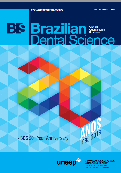Effect of the irrigation protocols on the elimination of dentin debris from simulated lateral canals
DOI:
https://doi.org/10.14295/bds.2018.v21i4.1644Abstract
Objective: Computed microtomography was used to evaluate the capacity of debris removal from simulated lateral canals, in conventional irrigation, passive ultrasonic irrigation (PUI), continuous passive irrigation (CUI), Endoactivator and EasyClean, for both types of motion (continuous and reciprocating). Material and Methods: Sixty acrylic incisors with 3 simulated lateral canals per tooth (cervical, middle and apical third) were instrumented with Reciproc 40/06 and then filled with dentin debris. The teeth were scanned and divided into 6 groups (n = 10) according to the irrigation protocol: G1 - conventional, G2 - PUI, G3 - CUI, G4 - Endoactivator, G5 - EasyClean continuous rotation and G6 - EasyClean reciprocating. After the irrigation protocols, the samples were scanned again. The initial and final volume images were analyzed and the percentage of debris removal were found for each group in all levels. Results: There were significant differences between the initial and final volume of debris after the protocols, with the exception of conventional irrigation group in the apical and cervical thirds, EasyClean reciprocating in the middle and cervical thirds, and CUI in the middle third. In the analysis between the groups: in the apical third, Endoactivator and PUI removed more debris than CUI (p < 0.05); in the middle and cervical thirds, PUI was more efficient than conventional irrigation, EasyClean reciprocating and CUI (p < 0.05). Conclusion: No method completely removed the debris. PUI was the method that showed greater effectiveness in cleaning the lateral canals.
Keywords
Root canal therapy; Microct; Dentin; Ultrasonic therapy.
Downloads
Downloads
Additional Files
Published
How to Cite
Issue
Section
License
Brazilian Dental Science uses the Creative Commons (CC-BY 4.0) license, thus preserving the integrity of articles in an open access environment. The journal allows the author to retain publishing rights without restrictions.
=================




























